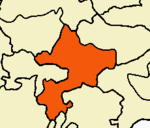Koranganatha Temple
Koranganatha Temple is a Hindu temple situated in the town of Srinivasanallur, about 50 kilometres from Tiruchirappalli. This temple was manage and protected by peoples of Muthuraiyar / Muthuraja community who believed as ancestors Medieval Cholas. The temple was constructed by the Medieval Cholas and is dedicated to the god Ranganatha. The temple is protected by the Archaeological Survey of India (ASI).
| Koranganathar temple | |
|---|---|
.jpg) | |
| Religion | |
| Affiliation | Hinduism |
| District | Tiruchirapalli |
| Location | |
| Location | Srinivasanallur |
| State | Tamil Nadu |
| Country | India |
| Geographic coordinates | 10.97°N 78.38°E |
History
Koranganatha temple is located in Srinivasanallur, a village located in the Trichy - Salem highway. The temple is dedicated to Hindu god Vishnu in the form of Ranganatha. The temple has a sanctum with a vimana over the sanctum and a four pillared hall. According to the temple records, the temple has multiple inscriptions from the Chola empire, none of which recording the construction of the temple. There are multiple images of Dakshinamurthy, Bhikshatana, Vishnu and few other legends indicating the various Hindu legends. According to historian Harle, the temple is counted among the four early extant temples of the Chola Empire, with the other three being Moovar Koil in Pudukottai district, Nageswaran temple at Kumbakonam and Brahmapureeswarar temple in Thanjavur district. These temples follow the Pallava architecture which are relatively small in size. They all have a fair-sized porch, locally called ardhamandapa attached to the sanctum, both of which are slightly below the ground level in a pit kind of structure. The structures are also predominantly built of stone.[1]
Architecture
Some historians believe that the temple is of Nagara style in the architecture of the vimana among its counterparts.[2] According to Reddy, the temple is atypical of Chola art is probably built by Parantaka I. The total cover length of the temple is 15.3 m (50 ft) and the shikara measures 15.3 m (50 ft). The sanctum is square in shape measuring 3.7 m (12 ft) and it has a small vestibule leading to a four pillared hall.[3] The sculpted figures are heavily ornamented than any other temple figures during the period.[4]
Notes
- Harle, James C. (1958). The Brahmapuriswara temple at Pullamangai (PDF). Bombay: Bhulabhai Memorial Institute. p. 9.
- Kramrisch, Stella (1976). The Hindu Temple, Volume 1. Motilal Banarsidass Publishers. p. 294. ISBN 9788120802230.
- Reddy, V. V. Subba (2009). Temples of South India. Gyan Publishing House. p. 112. ISBN 9788121210225.
- Singh, Upinder (2008). A History of Ancient and Early Medieval India: From the Stone Age to the 12th Century. Pearson Education India. ISBN 9788131711200.
References
- "Koranganatha Temple - Srinivasanallur". Government of India.
External links
| Wikimedia Commons has media related to Koranganathar temple, Srinivasanallur. |
.jpg)
.jpg)
.jpg)
